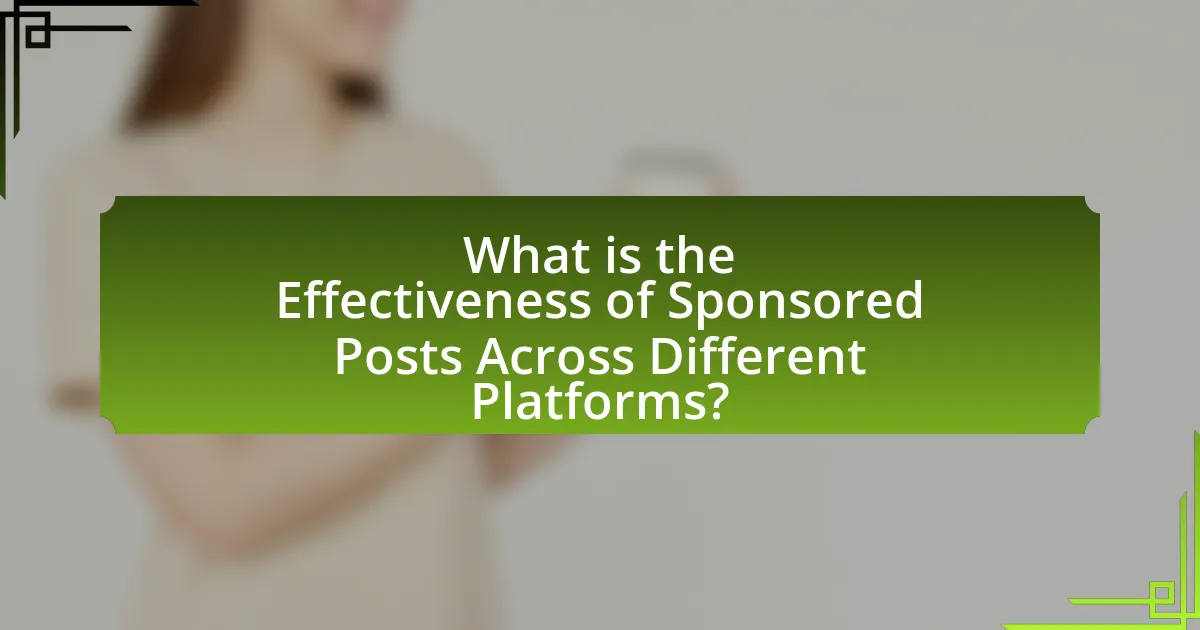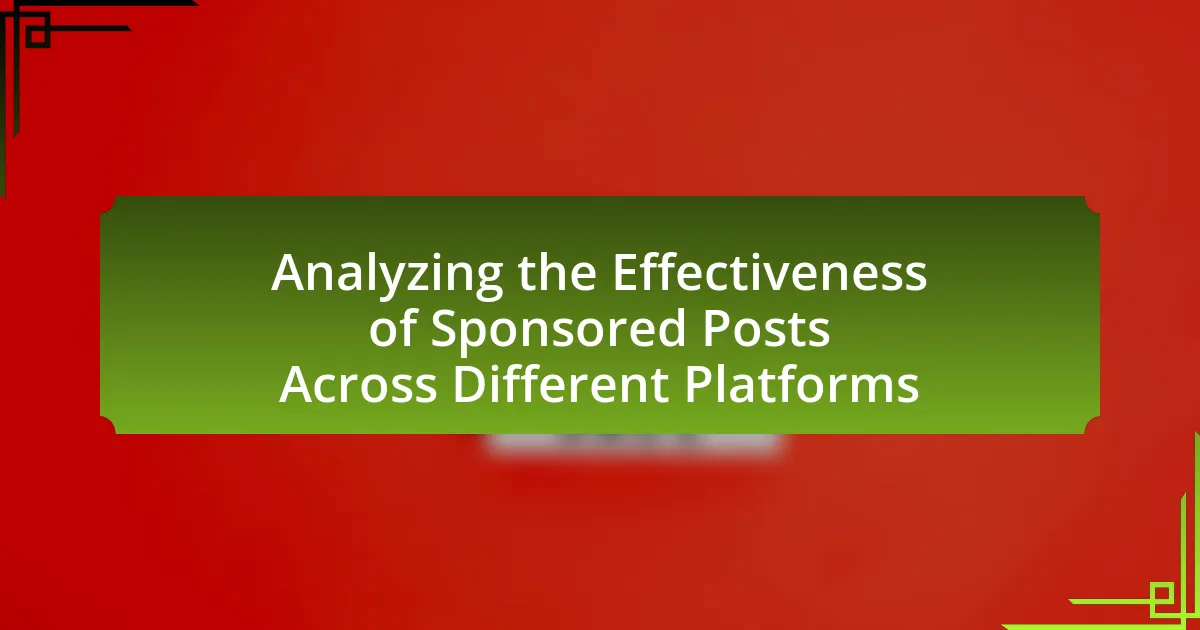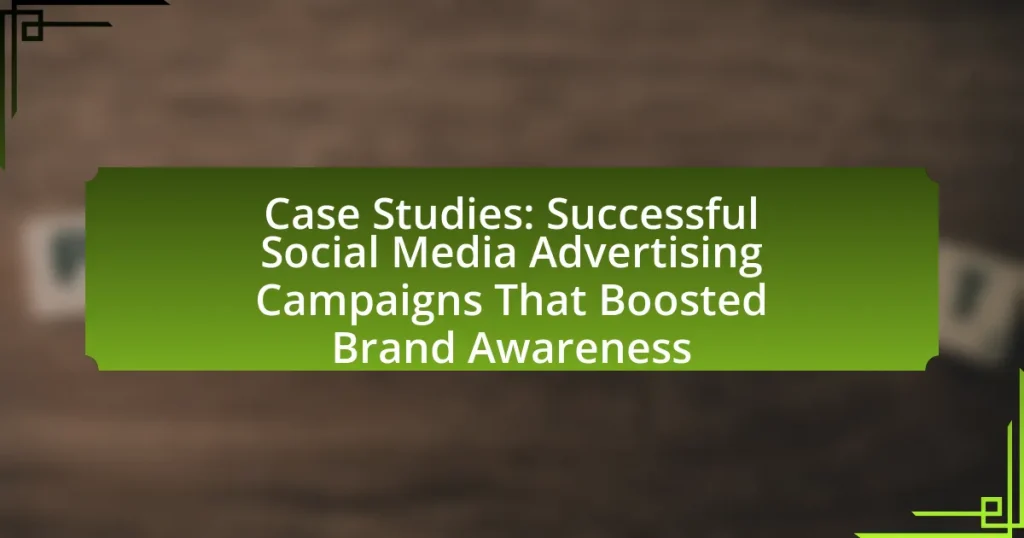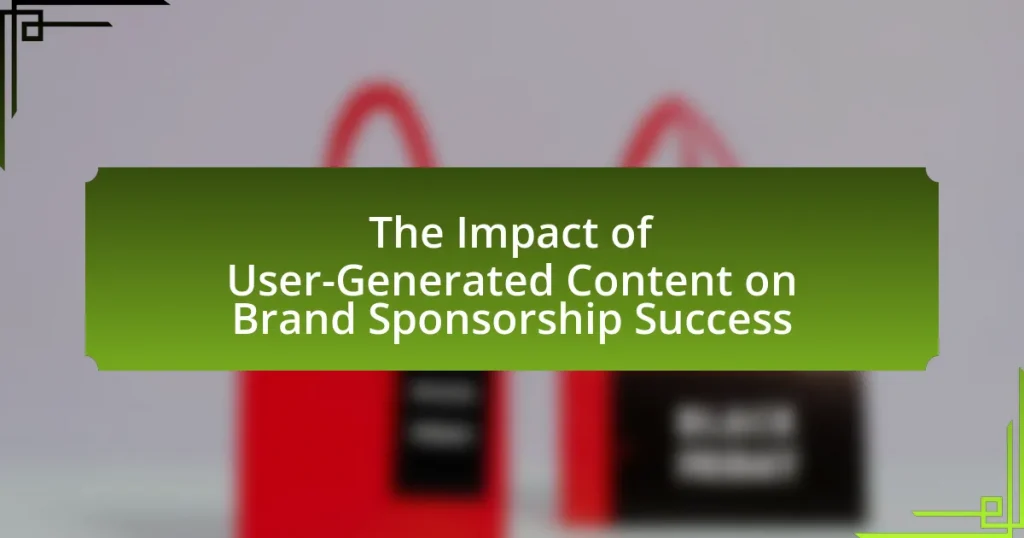The article analyzes the effectiveness of sponsored posts across various social media platforms, highlighting key metrics such as engagement rates, click-through rates, and conversion rates. It presents data indicating that platforms like Instagram and LinkedIn outperform others in terms of audience interaction and B2B marketing effectiveness. The discussion includes factors influencing sponsored post success, such as audience targeting, content quality, and platform selection, while also addressing challenges marketers face in measuring effectiveness. Additionally, best practices for optimizing sponsored posts and leveraging analytics for improved results are outlined, providing a comprehensive overview of strategies for enhancing marketing efforts through sponsored content.

What is the Effectiveness of Sponsored Posts Across Different Platforms?
The effectiveness of sponsored posts varies significantly across different platforms, with engagement rates and audience reach being key indicators. For instance, a study by HubSpot found that Instagram sponsored posts achieve an average engagement rate of 1.22%, while Facebook posts average around 0.08%. Additionally, LinkedIn sponsored content tends to perform well in B2B contexts, with a click-through rate of 0.39%, according to LinkedIn’s own data. These statistics illustrate that the platform’s audience and content type greatly influence the success of sponsored posts, making it essential for marketers to tailor their strategies accordingly.
How do we define effectiveness in the context of sponsored posts?
Effectiveness in the context of sponsored posts is defined by the ability of these posts to achieve specific marketing objectives, such as increasing brand awareness, driving engagement, or generating conversions. Metrics such as click-through rates, engagement rates, and conversion rates are commonly used to measure this effectiveness. For instance, a study by HubSpot found that businesses that utilize sponsored posts see an average increase of 24% in engagement compared to organic posts, demonstrating a clear impact on audience interaction.
What metrics are commonly used to measure effectiveness?
Common metrics used to measure effectiveness include engagement rate, conversion rate, reach, impressions, and return on investment (ROI). Engagement rate quantifies interactions such as likes, shares, and comments relative to total followers, indicating audience interest. Conversion rate measures the percentage of users who take a desired action, such as making a purchase, after interacting with a sponsored post, reflecting the post’s persuasive power. Reach indicates the total number of unique users who see the content, while impressions count the total views, providing insight into visibility. ROI evaluates the financial return generated from the investment in sponsored posts, calculated by comparing revenue generated to the cost of the campaign. These metrics collectively provide a comprehensive view of the effectiveness of sponsored posts across different platforms.
How do these metrics vary across different platforms?
Metrics such as engagement rates, reach, and conversion rates vary significantly across different platforms. For instance, Instagram typically shows higher engagement rates for sponsored posts, averaging around 1.22% compared to Facebook’s 0.08%, indicating that users are more likely to interact with content on Instagram. Additionally, reach can differ, with platforms like TikTok achieving viral potential due to its algorithm, which can expose posts to a wider audience quickly. Conversion rates also fluctuate, with LinkedIn often yielding higher B2B conversion rates, reported at 2.74%, compared to Instagram’s 1.08% for similar campaigns. These variations highlight the importance of selecting the right platform based on specific marketing goals and target audiences.
Why are sponsored posts important for brands and marketers?
Sponsored posts are important for brands and marketers because they enhance visibility and engagement with target audiences. By leveraging sponsored content, brands can reach specific demographics more effectively than through organic posts alone, as platforms like Facebook and Instagram allow for precise targeting based on user data. According to a study by the Interactive Advertising Bureau, 70% of consumers prefer to learn about products through content rather than traditional advertisements, highlighting the effectiveness of sponsored posts in capturing audience interest. This approach not only increases brand awareness but also drives conversions, making it a crucial strategy in modern marketing.
What role do sponsored posts play in digital marketing strategies?
Sponsored posts serve as a crucial component in digital marketing strategies by enhancing brand visibility and engagement. These posts allow businesses to reach targeted audiences through paid placements on social media platforms and websites, effectively increasing the likelihood of user interaction. For instance, a study by HubSpot found that 70% of marketers reported that sponsored content was more effective than traditional advertising in generating leads. This demonstrates that sponsored posts not only amplify reach but also contribute to higher conversion rates, making them an essential tool for marketers aiming to optimize their digital presence.
How do sponsored posts influence consumer behavior?
Sponsored posts significantly influence consumer behavior by enhancing brand visibility and credibility. Research indicates that 70% of consumers are more likely to make a purchase after seeing a sponsored post from a trusted influencer, as these endorsements create a sense of authenticity and relatability. Additionally, sponsored posts often utilize targeted advertising, which increases the likelihood of reaching consumers who are already interested in the product or service, thereby driving engagement and conversion rates. This targeted approach is supported by data showing that ads tailored to specific demographics can lead to a 50% increase in click-through rates compared to non-targeted ads.
What factors contribute to the effectiveness of sponsored posts?
The effectiveness of sponsored posts is primarily influenced by audience targeting, content quality, and platform selection. Audience targeting ensures that the sponsored content reaches individuals who are most likely to engage with it, increasing the likelihood of conversions. For instance, a study by HubSpot found that targeted ads can lead to a 50% higher click-through rate compared to non-targeted ads. Content quality plays a crucial role as well; engaging, relevant, and visually appealing posts are more likely to capture attention and drive interaction. According to a report by Sprout Social, posts with high-quality images receive 650% more engagement than those without. Lastly, the choice of platform affects effectiveness; different platforms cater to varying demographics and user behaviors, which can significantly impact engagement rates. For example, Instagram is particularly effective for visual content, while LinkedIn is better suited for B2B marketing.
How does audience targeting impact effectiveness?
Audience targeting significantly enhances the effectiveness of marketing campaigns by ensuring that messages reach the most relevant consumers. When brands tailor their content to specific demographics, interests, and behaviors, they increase engagement rates and conversion potential. For instance, a study by the Digital Marketing Institute found that targeted ads can lead to a 50% higher click-through rate compared to non-targeted ads. This precision in targeting not only optimizes advertising spend but also fosters a stronger connection between the brand and its audience, ultimately driving better results in sponsored posts across various platforms.
What is the significance of content quality in sponsored posts?
Content quality in sponsored posts is significant because it directly influences audience engagement and brand perception. High-quality content enhances credibility, making the sponsored message more persuasive and likely to resonate with the target audience. Research indicates that 70% of consumers prefer to learn about products through content rather than traditional advertising, highlighting the importance of well-crafted posts in driving consumer interest and action. Furthermore, platforms like Instagram and Facebook prioritize engaging content in their algorithms, meaning that higher quality posts are more likely to reach a broader audience, thereby maximizing the effectiveness of the sponsorship.
How do different platforms compare in terms of sponsored post effectiveness?
Different platforms exhibit varying levels of effectiveness for sponsored posts, with Instagram and Facebook generally leading in engagement rates. Research indicates that Instagram posts achieve an average engagement rate of 1.22%, while Facebook’s average is around 0.08%. Twitter and LinkedIn follow, with engagement rates of approximately 0.045% and 0.39%, respectively. These statistics highlight that visual-centric platforms like Instagram tend to foster higher user interaction, making them more effective for sponsored content compared to text-heavy platforms.
What are the unique features of Facebook that affect sponsored post performance?
Facebook’s unique features that affect sponsored post performance include its advanced targeting options, user engagement metrics, and algorithm-driven content distribution. The platform allows advertisers to target specific demographics, interests, and behaviors, which increases the relevance of sponsored posts to users. Additionally, Facebook provides detailed analytics on user interactions, such as likes, shares, and comments, enabling advertisers to measure engagement effectively. The platform’s algorithm prioritizes content based on user preferences and interactions, ensuring that sponsored posts reach the most relevant audience. These features collectively enhance the effectiveness of sponsored posts by improving targeting precision and engagement rates.
How does Instagram’s visual nature enhance sponsored post engagement?
Instagram’s visual nature significantly enhances sponsored post engagement by leveraging eye-catching imagery and videos that capture user attention. The platform’s design prioritizes visuals, allowing brands to showcase products in a compelling manner, which can lead to higher interaction rates. Research indicates that posts with images receive 650% higher engagement than text-only posts, demonstrating the effectiveness of visual content in driving user interaction. Additionally, Instagram’s algorithm favors visually appealing content, further amplifying the reach and visibility of sponsored posts, thereby increasing the likelihood of user engagement.
What advantages does LinkedIn offer for B2B sponsored posts?
LinkedIn offers several advantages for B2B sponsored posts, primarily its professional audience and targeting capabilities. The platform has over 900 million members, predominantly consisting of professionals and decision-makers, which enhances the likelihood of reaching relevant business audiences. Additionally, LinkedIn’s advanced targeting options allow advertisers to segment their audience based on industry, job title, company size, and more, ensuring that sponsored content is delivered to the most appropriate users. This targeted approach results in higher engagement rates and improved return on investment for B2B campaigns, as evidenced by a study from HubSpot indicating that LinkedIn generates 80% of B2B leads from social media.
What challenges do marketers face when analyzing sponsored post effectiveness?
Marketers face several challenges when analyzing sponsored post effectiveness, primarily due to the difficulty in measuring direct impact and attributing results to specific posts. One significant challenge is the lack of standardized metrics across different platforms, which complicates comparisons and evaluations. For instance, engagement rates, click-through rates, and conversion metrics can vary widely, making it hard to assess overall performance accurately. Additionally, marketers often struggle with data fragmentation, as insights may be scattered across multiple tools and platforms, hindering a cohesive analysis. Furthermore, the influence of external factors, such as market trends and audience behavior, can skew results, making it challenging to isolate the effectiveness of a sponsored post. These complexities necessitate a more nuanced approach to data analysis and interpretation in order to derive actionable insights.
How do algorithm changes on platforms affect sponsored post visibility?
Algorithm changes on platforms significantly impact sponsored post visibility by altering how content is prioritized and displayed to users. For instance, when a platform modifies its algorithm to favor organic engagement over paid promotions, sponsored posts may receive less visibility, resulting in lower reach and engagement rates. A study by Buffer in 2020 indicated that changes in Facebook’s algorithm reduced organic reach for brands by approximately 50%, demonstrating the direct correlation between algorithm adjustments and sponsored content performance. Thus, the effectiveness of sponsored posts is closely tied to the underlying algorithms governing content visibility on social media platforms.
What are the limitations of current measurement tools for sponsored posts?
Current measurement tools for sponsored posts have several limitations, including a lack of standardized metrics, difficulty in accurately attributing conversions, and challenges in measuring long-term engagement. These tools often rely on varying definitions of success, which complicates comparisons across platforms. For instance, while some tools may focus on impressions or clicks, others may prioritize engagement rates, leading to inconsistent data interpretation. Additionally, many measurement tools struggle to track user behavior beyond the initial interaction, making it hard to assess the true impact of sponsored content on brand loyalty or customer retention. This inconsistency and lack of comprehensive tracking can result in misleading conclusions about the effectiveness of sponsored posts.
What best practices can enhance the effectiveness of sponsored posts?
To enhance the effectiveness of sponsored posts, brands should focus on targeting the right audience, creating high-quality content, and utilizing platform-specific features. Targeting the right audience ensures that the sponsored posts reach individuals who are most likely to engage with the content, which can be achieved through demographic and interest-based targeting tools available on platforms like Facebook and Instagram. High-quality content, including visually appealing images and compelling copy, increases user engagement; studies show that posts with images receive 94% more views than those without. Additionally, leveraging platform-specific features, such as Instagram Stories or Facebook’s carousel ads, can improve visibility and interaction rates. These practices are supported by data indicating that tailored content and strategic targeting significantly boost engagement metrics across various social media platforms.
How can brands optimize their targeting strategies for better results?
Brands can optimize their targeting strategies for better results by leveraging data analytics to understand consumer behavior and preferences. By analyzing metrics such as engagement rates, click-through rates, and demographic information, brands can identify their most responsive audience segments. For instance, a study by Nielsen found that targeted advertising can increase conversion rates by up to 50%. Additionally, utilizing A/B testing allows brands to refine their messaging and creative elements based on real-time feedback, ensuring that campaigns resonate more effectively with the intended audience. This data-driven approach not only enhances targeting precision but also maximizes return on investment in advertising spend.
What types of content are most effective for sponsored posts across platforms?
Visual content, particularly images and videos, is the most effective type of content for sponsored posts across platforms. Research indicates that posts featuring visuals receive 94% more views than those without, significantly increasing engagement rates. For instance, on Instagram, video posts generate 49% more engagement compared to image posts, highlighting the platform’s preference for dynamic content. Additionally, Facebook reports that video content is shared 1200% more than text and image content combined, reinforcing the effectiveness of visual storytelling in sponsored posts.
How can brands leverage analytics to improve future sponsored posts?
Brands can leverage analytics by analyzing engagement metrics, audience demographics, and conversion rates from previous sponsored posts to refine their strategies. By utilizing tools like Google Analytics and social media insights, brands can identify which content resonates most with their target audience, allowing them to tailor future posts for maximum impact. For instance, a study by HubSpot found that posts with personalized content receive 42% more engagement, demonstrating the effectiveness of data-driven adjustments. Additionally, tracking performance over time enables brands to optimize posting times and formats, ensuring that future sponsored posts align with audience preferences and behaviors.



